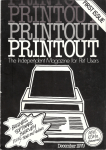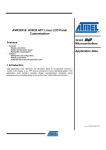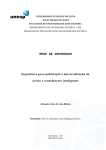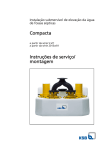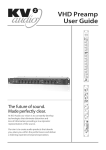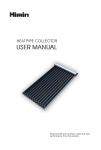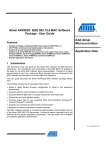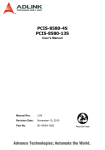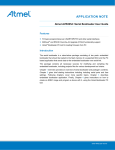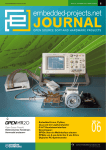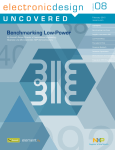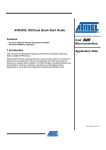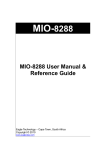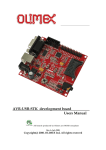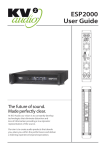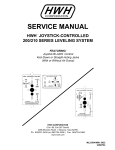Download AVR32 Series
Transcript
The World of AVR32 Series RISC Microcontrollers Product Overview 2008 32-bit AVR32 RISC MCU for Linux® Application and Real-Time System ■ USB2.0 HS Device and HS OTG ■ LCD Controller and Graphic Accelerator ■ Up to 2 x Fast Ethernet MAC 10/100Mbit/s ■ Fast embedded Flash/SRAM and external bus interface ■ Up to 280DMIPS at 200MHz ■ Linux® and RTOS support MSC - Distributor of AVR32 RISC MCU Families Welcome to the World of Atmel’s RISC microcontrollers Join the big world of Atmel’s 8-bit and 32-bit RISC MCU families! From lowest cost ATTINY, high performance ATMEGA or new XMEGA family, Atmel’s 8-bit AVR portfolio covers devices from 16 MIPS up 32 MIPS with pin counts from 8 up to 100 pins. Flash memories from 1K up to 256K are available. Atmel’s RISC architectures Atmel’s new AVR32 32-bit core is introduced in UC3 flash based derivates and in the AP7 application processor products. A lot of intelligent technologies make this core the winner in performance and power consumption over all existing 32-bit technologies. Here, will find flash based products up to 512K with a lot of communication interfaces as well as high performance processors with MMU and cashes especially for embedded Linux, which is supported directly by Atmel. Atmel’s SAM ARM® families cover a broad range of products from flash based SAM7 and SAM9 products as well as bigger SAM9 machines for Windows CE® and embedded Linux. A rich set of communication peripherals, lots of smart implementations and different available development tools and operating systems in the market make this products very successful. Common peripherals Migration Both AVR32 and SAM ARM® use many common peripherals, enabling migration between the families much more easier, than jumping between different MCU technology. Common tools Tools AVR32, AVR and XMEGA products come with dedicated free of charge AVR Studios and can be debugged with JTAGICEMK2. So feel free to start with AVR, enlarge your application to XMEGA and proceed to AVR32 MCUs with the same set of tools. 2 AVR32 Family Overview AP7 Family Roadmap The AVR32 Family is currently the most expanding product in the 32-bit area. This is valid for both, the flash-less AP7 Family and the embedded flash UC3. The AP7 family is equipped with all system components and peripherals to build up digital systems for process controlling and visualization which normally are engaged with full fledged operating system like Linux. The AT32AP7000 was the first product on the market which features highest performance at low power consumption and was targeting to the portable console market. But the huge offer in software, specially the Linux Kernel and driver support directly from Atmel, was ideal for a lot of customer to use this package for their application. All next products based on AP7 will have new or additional peripherals and also will be shrinked for more speed and lower power consumption. UC3 Family Roadmap The UC3 family is an optimized version of the AVR32 Core for real-time systems and will be equipped with embedded flash. It optimally fits into application where highest performance at low power consumption is needed and also PCB space is less available. The UC3 Core implements a high efficient DSP instruction set and speed up signal processing applications significantly. The UC3 family is planned to be automotive AEC-Q100 as well. 3 Family Overview AT32AP7000 The AT32AP7000 is the first AVR32-based processor family and the first to integrate on a single chip, virtually all the functionalities required for multimedia systems deployed in cell phones, digital cameras, PDAs, automotive infotainment, set top boxes, and home entertainment systems, as well as network switches/routers and printers. The embedded Pixel-Coprocessor accelerates processing of images and video streams and is directly connected to the core to perform single cycle execution on processor speed. AT32AP7000 in brief System 7 AVR32, 150MHz Pixel-Coprocessor 16-layer AHB Matrix Debug JTAG / Nexus Class III Caches 16K-I, 16K-D MMU The AT32AP7000 operates at 210 MIPS with a 150 MHz clock. It features 32K bytes of SRAM directly connected to the high-speed bus matrix, an external bus interface with controllers for SDRAM and static memories including NAND Flash and CompactFlash™ with ECC. Its extensive peripheral set includes an USB High Speed Device interface, two 10/100 Base-T Ethernet MAC, Image Sensor Interface, Multimedia Card Interface (MCI), a LCD-Controller for TFT and STN Displays, Synchronous Serial Controllers (SSC), USARTs, Master/Slave Serial Peripheral Interfaces (SPI), two three-channel 16-bit Timer Counter (TC) and a Two Wire Interface (TWI). Up to five GPIO Controller (each 32-bit wide) are selecting general I/O’s or do connect the peripherals to dedicated pins via multiplexer. Peripheral DMA channels maximize the data throughput between these interfaces and the on- and off-chip memories. The AT32AP7000 is available in a 256-ball CTBGA RoHS-compliant package providing up to 160 GPIO multiplexed with peripherals. AT32AP7000 Blockdiagram yes Memory Flash - SRAM 2 x 16KB Ext. Bus interface 16/32-bit dynamic, 8/16/32-bit static, NAND (ECC), CompactFlash™ Boot EBI CS0 Communication Ethernet 2 x MAC 10/100 RMII/MII with DMA USB UDP UHP 1 USB2.0 HS Device U(S)ART 4 with DMA SPI 2 with DMA TWI (I²C) 1 (Master) SSC 3 with DMA Timer 16-bit 6 x with Cap/Com RTT 1 Watchdog 1 PWM 4 ch / 20-bit Multimedia LCD Contr. 2048 x 2048 24-bit Camera IF 1 MMC IF 1 Audio DAC 1 AC97 1 Misc. AT32AP7000 Development Tools AP7000 is supported by the ATSTK1000 evaluation kit and AT90JTAGICE-mkII debugger. Also an ultra low-cost Network Reference Design Kit ATNGW100 with pre-installed Linux Image is available. PS2 1 I/O 160 max. Oscillators 2 x Osc., 2 x PLL System POR, Shut Down Ctrl. Evaluation Boards All related Software and documentation may be downloaded via www.atmel.com/ products/avr32 : - Ready to use example projects - Linux demonstration software ATSTK1000 Resources - Getting Started Application Notes SDRAM - Schematics, BOM and Gerber files Flash 8MByte SD-Card 256MByte - Free Atmel tools (Linux Kernel and BSP) ATSTK1000 is equipped with AT32AP7000-CTUT (CTBGA). MSC’s AT32AP7000-Startup Paket gives you all you need for your first AP7000 design: ATSTK1000, AT90JTAGICE-mkII. The BSP and Linux Kernel is supported by Atmel and can be downloaded free of cost. 8MByte ATNGW100 Resources SDRAM 32MByte Flash 8MByte DataFlash™ 8MByte Schematics, BOM, Gerber etc. provided by Atmel. 4 Family Overview AT32AP7001 The AT32AP7001 is a device reduction of the full-fledged AP7000 related to some peripherals. It can be used in applications where no Ethernet connection and no process visualization are needed. The AP7001 can be used for applications deployed in cell phones, digital cameras, automotive infotainment, process automation, set top boxes, and home entertainment systems. The embedded Pixel-Coprocessor accelerates processing of images and video streams and is directly connected to the core to perform single cycle execution on processor speed. The AT32AP7001 operates at 210 MIPS with a 150 MHz clock. It features 32K bytes of SRAM directly connected to the high-speed bus matrix, an external bus interface with controllers for SDRAM and static memories including NAND Flash and CompactFlash™ with ECC. Its extensive peripheral set includes a USB High Speed Device interface, Image Sensor Interface, Multimedia Card Interface (MCI), Synchronous Serial Controllers (SSC), USARTs, Master/Slave Serial Peripheral Interfaces (SPI), two three-channel 16-bit Timer Counter (TC), and a Two Wire Interface (TWI). Up to three GPIO Controller (each 32-bit wide) are selecting general I/O’s or do connect the peripherals to dedicated pins via multiplexer. Peripheral DMA channels maximize the data throughput between these interfaces and the on- and off-chip memories. The AT32AP7001 is available in a 208-ball QFP RoHS-compliant package AT32AP7001 Blockdiagram AT23AP7001 in brief System CPU AVR32, 150MHz Pixel-Coprocessor 16-layer AHB Matrix Debug JTAG / Nexus Class III Caches 16K-I, 16K-D MMU yes Memory Flash - SRAM 2 x 16KB Ext. Bus interface 16/32-bit dynamic, 8/16/32-bit static, NAND (ECC), CompactFlash™ Boot EBI CS0 Communication USB UDP UHP 1 USB2.0 HS Device U(S)ART 4 with DMA SPI 2 with DMA TWI (I²C) 1 (Master) SSC 3 with DMA Timer 16-bit 6 x with Cap/Com RTT 1 Watchdog 1 PWM 4 ch / 20-bit Multimedia Camera IF 1 MMC IF 1 Audio DAC 1 AC97 1 Misc. PS2 1 I/O 160 max. Oscillators 2 x Osc., 2 x PLL System POR, Shut Down Ctrl. AT32AP7000 Development Tools Evaluation Boards AP7000 is supported by the ATSTK1000 evaluation kit and AT90JTAGICE-mkII debugger. Also an ultra low-cost Network Reference Design Kit ATNGW100 with pre-installed Linux Image is available. All related Software and documentation may be downloaded via www.atmel.com/ products/avr32 : ATSTK1000 Resources - Ready to use example projects SDRAM - Linux demonstration software Flash 8MByte SD-Card 256MByte - Getting Started Application Notes - Schematics, BOM and Gerber files - Free Atmel tools (Linux Kernel and BSP) ATSTK1000 is equipped with AT32AP7000-CTUT (CTBGA). MSC’s AT32AP7000-Startup Paket gives you all you need for your first AP7000 design: ATSTK1000, AT90JTAGICE-mkII. The BSP and Linux Kernel is supported by Atmel and can be downloaded free of cost. 8MByte ATNGW100 Resources SDRAM 32MByte Flash 8MByte DataFlash™ 8MByte Schematics, BOM, Gerber etc. provided by Atmel. 5 Family Overview AT32AP7002 The AT32AP7002 is a device reduction of the full-fledged AP7000 related to some peripherals. It can be used in applications where no Ethernet connection is needed but process visualization is an issue. The AP7002 can be used for applications deployed in cell phones, digital cameras, automotive infotainment, process automation, set top boxes, and home entertainment systems. The embedded Pixel-Coprocessor accelerates processing of images and video streams and is directly connected to the core to perform single cycle execution on processor speed. AT32AP7002 in brief System CPU AVR32, 150MHz Pixel-Coprocessor 16-layer AHB Matrix Debug JTAG / Nexus Class III Caches 16K-I, 16K-D MMU The AT32AP7002 operates at 210 MIPS with a 150 MHz clock. It features 32K bytes of SRAM directly connected to the high-speed bus matrix, an external bus interface with controllers for SDRAM and static memories including NAND Flash and CompactFlash™ with ECC. Its extensive peripheral set includes a USB High Speed Device interface, Image Sensor Interface, Multimedia Card Interface (MCI), a LCD-Controller for TFT and STN Displays, Synchronous Serial Controllers (SSC), USARTs, Master/Slave Serial Peripheral Interfaces (SPI), two three-channel 16-bit Timer Counter (TC) and a Two Wire Interface (TWI). Up to three GPIO Controller (each 32-bit wide) are selecting general I/O’s or do connect the peripherals to dedicated pins via multiplexer. Peripheral DMA channels maximize the data throughput between these interfaces and the on- and off-chip memories. The AT32AP7002 is available in a 196-ball CTBGA RoHS-compliant package providing up to 88 GPIO multiplexed with peripherals. AT32AP7002 Blockdiagram yes Memory Flash - SRAM 2 x 16KB Ext. Bus interface 8/16/32-bit static, 16/32-bit dynamic, NAND (ECC), CompactFlash™ Boot EBI CS0 Communication USB UDP UHP 1 USB2.0 HS Device U(S)ART 4 with DMA SPI 2 with DMA TWI (I²C) 1 (Master) SSC 3 with DMA Timer 16-bit 6 x with Cap/Com RTT 1 Watchdog 1 PWM 4 ch / 20-bit Multimedia LCD Contr. 2048 x 2048 24-bit Camera IF 1 MMC IF 1 Audio DAC 1 AC97 1 Misc. PS2 1 I/O 160 max. Oscillators 2 x Osc., 2 x PLL System POR, Shut Down Ctrl. AT32AP7000 Development Tools Evaluation Boards AP7000 is supported by the ATSTK1000 evaluation kit and AT90JTAGICE-mkII debugger. Also an ultra low-cost Network Reference Design Kit ATNGW100 with pre-installed Linux Image is available. All related Software and documentation may be downloaded via www.atmel.com/ products/avr32 : - Ready to use example projects - Linux demonstration software ATSTK1000 Resources SDRAM 8MByte Flash 8MByte SD-Card 256MByte - Getting Started Application Notes - Schematics, BOM and Gerber files - Free Atmel tools (Linux Kernel and BSP) ATSTK1000 is equipped with AT32AP7000-CTUT (CTBGA). MSC’s AT32AP7000-Startup Paket gives you all you need for your first AP7000 design: ATSTK1000, AT90JTAGICE-mkII. The BSP and Linux Kernel is supported by Atmel and can be downloaded free of cost. 6 ATNGW100 Resources SDRAM 32MByte Flash 8MByte DataFlash™ 8MByte Schematics, BOM, Gerber etc. provided by Atmel. Family Overview AT32AP7200 The AT32AP7200 is the second Generation full-fledged AVR32-based processor families and expands the previous version by additional peripherals required for multimedia systems deployed in cell phones, digital cameras, PDAs, automotive infotainment, set top boxes, and home entertainment systems, as well as network switches/routers and printers. The embedded Pixel-Coprocessor accelerates processing of images and video streams and is directly connected to the core to perform single cycle execution on processor speed. AT32AP7200 in brief System CPU AVR32, 200MHz Pixel-Coprocessor 9-layer AHB Matrix Debug JTAG / Nexus Class III Caches 16K-I, 16K-D MMU The AT32AP7200 operates at 280 DMIPS with a 200 MHz clock. It features 32K bytes of SRAM directly connected to the high-speed bus matrix, an external bus interface with controllers for SDRAM and static memories including NAND Flash and CompactFlash™ with ECC. Its extensive peripheral set includes a USB High Speed Host interface, a High-Speed On-The-Go interface, one 10/100 Base-T Ethernet MAC, Multimedia Card Interface (MCI), a LCD-Controller for TFT and STN Displays with a Image Post Processor, Synchronous Serial Controllers (SSC), USARTs, Master/ Slave Serial Peripheral Interfaces (SPI), two three-channel 16-bit Timer Counter (TC), a Two Wire Interface (TWI) and a six-channel 10-bit ADC with Touch Screen support. Up to six GPIO Controller (each 32-bit wide) are selecting general I/O’s or do connect the peripherals to dedicated pins via multiplexer. Peripheral DMA channels maximize the data throughput between these interfaces and the on- and off-chip memories. The AT32AP7200 is available in a 324-ball BGA RoHS-compliant package providing up to 189 GPIO multiplexed with peripherals. AT32AP7200 Blockdiagram yes Memory Flash - SRAM 2 x 32KB Ext. Bus interface 8/16/32-bit static, 16/32-bit dynamic, NAND (ECC), CompactFlash™ Boot EBI CS0 Communication Ethernet 1 x MAC 10/100 RMII/MII with DMA USB UDP UHP 1 USB2.0 HS OTG 1 USB2.0 HS Host U(S)ART 6 with DMA SPI 1 with DMA / 4 Ch. TWI (I²C) 2 (Master/Slave) SSC 3 with DMA Timer 16-bit 6 x with Cap/Com RTT 1 Watchdog 1 PWM 4 ch / 20-bit Multimedia LCD Contr. 2048 x 2048 24-bit MPOP Media Post Processor MMC IF 1 Audio DAC 1 AC97 1 Misc. AT32AP7200 Development Tools The AT32AP7200 will be supported by a future evaluation board and the existing AT90JTAGICE-mkII debugger. The evaluation board will be designed for industrial use with pre-installed Linux Image and may be ordered in high quantities as well. ADC Touch Screen Support Keypad 1 x Rotary Encoder DIE IF 1 Oscillators 3 x Osc., 3 x PLL System POR, Shut Down Ctrl. Schematics, BOM, Gerber etc. provided by Atmel. All related Software and documentation may be downloaded via www.atmel.com/ products/avr32 : - Ready to use example projects - Linux demonstration software - Getting Started Application Notes - Schematics, BOM and Gerber files - Free Atmel tools (Linux Kernel and BSP) ATSTK1000 is equipped with AT32AP7000-CTUT (BGA). MSC’s AT32AP7200-Startup Paket gives you all you need for your first AP7000 design: The Evaluation Board and the AT90JTAGICE-mkII. The BSP and Linux Kernel is supported by Atmel and can be downloaded free of cost. 7 Family Overview AT32UC3A The AT32UC3A is based on the high-performance AVR32 core with logic optimization for real-time applications. Cache and MMU have been removed and instead a memory protection unit (MPU) was added. Also the core pipeline was reduced to a 3-stage pipeline to achieve the requirements needed for real-time systems. The AT32UC3A operates at 80 DMIPS with a 66 MHz clock. It features up to 64K bytes of SRAM directly connected to the core and performs single cycle access at maximum processor speed. The AT32UC3A family is designed for communication systems providing fast Ethernet 10/100Mbits/s and Full-Speed USB2.0 OTG at very low power consumption. Additional an external bus interface with controllers for SDRAM and static memories expands the embedded Flash and SRAM by cost effective memory options and also do provide more system functionality. Synchronous Serial Controllers (SSC), many USART’s, Master/Slave Serial Peripheral Interfaces (SPI), two three-channel 16-bit Timer Counter (TC), a Two Wire Interface (TWI) and a 10-bit ADC are part of this implementation and are speed up by the peripheral DMA controller to reduce CPU intervention. Up to 109-Pins are controlled by the Parallel I/O Controller and do switch connection for general purpose I/O’s or peripherals. The AT32UC3A is available in a 144-pin TQFP RoHS-compliant package providing all described functionality and also in a 100-pin TQFP package with no external bus interface. AT32UC3A in brief System CPU AVR32, 66MHz High-Speed AHB Matrix Debug JTAG / Nexus Class 2+ Caches - MPU yes Memory Flash 128/256/512KB SRAM 32/64/64KB Ext. Bus interface 8/16-bit static, 16-bit dynamic, Boot DFU Bootloader Communication Ethernet 1 x MAC 10/100 RMII/MII with DMA USB UDP UHP 1 USB2.0 FS OTG U(S)ART 4 with DMA SPI 2 with DMA TWI (I²C) 1 with DMA SSC AT32UC3A Blockdiagram 1 with DMA Timer 16-bit 3 x with Cap/Com RTC 1 Watchdog 1 PWM 7 ch / 16-bit Analogue ADC 10-bit / 8ch Misc. I/O 109/69 Oscillators System 115KHz RC 2 x Osc., 2 x PLL POR, BOD Evaluation Boards ATEVK1100 Resources AT32UC3A Development Tools The AT32UC3A is supported by ATEVK1100 evaluation kit and AT90JTAGICE-mkII debugger. It is pre-installed with a Panel Controller application also available in source code and support Mass-Storage Device Class a Web Server Application and much more. All source code is available through the UC3A Software Framework free of cost. It may be downloaded via www.atmel.com/products/avr32 : - Ready to use example projects - Control Panel demonstration software - Getting Started Application Notes - Schematics, BOM, Gerber files - Free Atmel tools (AVR32 Studio Integrated Development Tool) ATEVK1100 is equipped with AT32UC3A0512-ALUT (TQFP144). 8 SDRAM 16Mbit (1M x 16) DataFlash 8MByte SD-Card Slot only Ethernet RJ-45 USART 2 x RS232 USB MiniAB Display 4 x 20 Characters (SPI) Schematics, BOM, Gerber etc. provided by Atmel. Family Overview AT32UC3B The AT32UC3B is based on the high-performance AVR32 core with logic optimization for real-time applications. Cache and MMU have been removed and instead a memory protection unit (MPU) was added. Also the core pipeline was reduced to a 3-stage pipeline to achieve the requirements needed for real-time systems. The AT32UC3B operates at 75 DMIPS with a 60 MHz clock. It features up to 32K bytes of SRAM directly connected to the core and performs single cycle access at maximum processor speed. The AT32UC3B family is designed for general purpose low pin-count applications providing Full-Speed USB2.0 OTG at very low power consumption. This family is specially fabricated in a very low leakage process which results in 23mA@60MHz at 3.3V and ideally fits into battery powered applications. Synchronous Serial Controllers (SSC), many USART’s, Master/Slave Serial Peripheral Interface (SPI), one three-channel 16-bit Timer Counter (TC), a Two Wire Interface (TWI) and a 10-bit ADC are part of this implementation and are speed up by the peripheral DMA controller to reduce CPU intervention. Up to 44-Pins are controlled by the Parallel I/O Controller and provide connections for general purpose I/O’s or peripherals. The AT32UC3B is available in a 64-pin TQFP and 64-pin QFN RoHS-compliant package providing all described functionality. Also a 48-pin TQFP package and a 48-pin QFN package with reduced functionality can be offered. AT32UC3B Blockdiagram AT32UC3B in brieff System CPU AVR32, 60MHz High-Speed AHB Matrix Debug JTAG / Nexus Class 2+ Caches - MPU yes Memory Flash 64/128/256KB SRAM 16/32/32KB Boot DFU Bootloader Communication USB UDP UHP 1 USB2.0 FS OTG U(S)ART 3 with DMA SPI 1 with DMA TWI (I²C) 1 with DMA SSC 1 with DMA Timer 16-bit 3 x with Cap/Com RTC 1 Watchdog 1 PWM 7 ch / 16-bit Analogue ADC 10-bit / 8ch Misc. I/O 44/28 Oscillators System 115KHz RC 2 x Osc., 2 x PLL POR, BOD Evaluation Boards ATEVK1100 Resources DataFlash 8MByte SD-Card Slot only Sensors AT32UC3B Development Tools The AT32UC3B is supported by ATEVK1101 evaluation kit and AT90JTAGICE-mkII debugger. It is pre-installed with a Panel Controller application also available in source and a PC based Java based Dialog example to provide a quick overview. All source code is available by the UC3B Software Framework free of cost. USART Accelerometer Ligth, Temperature 1 x RS232 USB MiniAB Control Joystick Schematics, BOM, Gerber etc. provided by Atmel. It may be downloaded via www.atmel.com/products/avr32 : - Ready to use example projects - Control Panel demonstration software - Getting Started Application Notes - Schematics, BOM, Gerber files - Free Atmel tools (AVR32 Studio Integrated Development Env.) ATEVK1101 is equipped with AT32UC3A0256-A2UT (TQFP64). 9 AVR32 Selection Guide USART/DBGU Enhanced USART SPI TWI SSC CAN USB Device HS/FS USB Host FS / OTG Ethernet MAC10/100 AES & Triple-DES y y y 11 - 4/- 4 2 1 3 - HS - 2 - AT32AP7001-ALUT AVR32 yes/16KB/16KB 150 2x16K - - y y y 7 - 4/- 4 2 1 3 - HS - - - AT32AP7002-CTUT/R AVR32 yes/16KB/16KB 150 2x16K - - y y y 8 - 4/- 4 2 1 3 - HS - - - AT32AP7200-CTUT AVR32 yes/16KB/16KB 200 2x32K - yes y y y 13 - 6/- 6 4 2 3 - HS HS OTG 1 Audio DAC LIN/J1587 USART - AC97 Peripheral DMA - Graphic Acceleration Mem-to-Mem DMA 2x16K LCD Controller SDRAM EBI 150 Camera Interface External Businterface yes/16KB/16KB MMU/ I-D Cache AVR32 CORE BOOT ROM Bytes Video FLASH Bytes (x16/x32) Communication SRAM Bytes (x32) Memory MHz (@85°C) Core AT32AP7000-CTUT/R Device AT32 AVR32 Series Family, Part y y - y y y - - y y y y - y y - - y y y - AP7000 AT32 AP7000 Multimedia, low cost, single chip Flashless MCUs UC3B UC3 AT32 UC3 low cost, single chip Flash MCUs AT32UC3A0128-ALUT UC3 MPU/no/no 66 32K 128K - y y - 15 - 4/- 4 2 1 1 - - FS OTG 1 - - - - - - AT32UC3A0256-ALUT UC3 MPU/no/no 66 64K 256K - y y - 15 - 4/- 4 2 1 1 - - FS OTG 1 - - - - - - AT32UC3A0512-AL UT UC3 MPU/no/no 66 64K 512K - y y - 15 - 4/- 4 2 1 1 - - FS OTG 1 - - - - - - AT32UC3A1128-AUT UC3 MPU/no/no 66 32K 128K - - - - 15 - 4/- 4 2 1 1 - - FS OTG 1 - - - - - - AT32UC3A1256-AUT UC3 MPU/no/no 66 64K 256K - - - - 15 - 4/- 4 2 1 1 - - FS OTG 1 - - - - - - AT32UC3A1512-AUT UC3 MPU/no/no 66 64K 512K - - - - 15 - 4/- 4 2 1 1 - - FS OTG 1 - - - - - - AT32UC3B064-A2UT/Z2UT UC3 MPU/no/no 60 16K 64K - - - - 7 - 3/- 2 1 1 1 - - FS OTG - - - - - - - AT32UC3B0128-A2UT/Z2UT UC3 MPU/no/no 60 32K 128K - - - - 7 - 3/- 2 1 1 1 - - FS OTG - - - - - - - AT32UC3B0256-A2UT/Z2UT UC3 MPU/no/no 60 32K 256K - - - - 7 - 3/- 2 1 1 1 - - FS OTG - - - - - - - AT32UC3B164-AUT/Z1UT UC3 MPU/no/no 60 16K 64K - - - - 7 - 3/- 3 1 1 - - FS - - - - - - - - AT32UC3B1128-AUT/Z1UT UC3 MPU/no/no 60 32K 128K - - - - 7 - 3/- 3 1 1 - - FS - - - - - - - - AT32UC3B1256-AUT/Z1UT UC3 MPU/no/no 60 32K 256K - - - - 7 - 3/- 3 1 1 - - FS - - - - - - - - AVR32 AP7 Series High-Performance MCU for Linux-base Applications: The AT32AP7 was designed to fit into high-performance, low-power consuming Systems for process control and visualization. The core is equipped with a Memory-Management-Unit (MMU) and Cache for Instructions and Data and so prepared to run fullfledged operation systems like Linux. The core of the AT32AP7 family is attached to a Vector-Multiplication-Unit (Pixel Coprocessor) which may be used to scale or rotate images as well as for color conversion algorithm. The embedded LCD controller supports STN and TFT display up to 2048x2048 pixel resolution at 8 pixels per color. Several other media interfaces like Audio Codec’s, Multimedia Card and highspeed USB device interfaces opens a wide range of applications needed in consumer, automotive and industrial areas. 10 10- bit DAC I/O Pins High-Current-Pads Brown Out Detection Power On Reset RC Oscillator Cryst.Oscillator/PLL PGM Clock Out Vcc Core (V) Vcc I/O (V) 4 - - - y - - 160 - - y - 2/2 5 1.65-1.95 3.0-3.6 y - PS2 6 4 - - - y - - 90 - - y - 2/2 5 1.65-1.95 3.0-3.6 y - PS2 6 4 - - - y - - 88 - - y - 2/2 5 1.65-1.95 3.0-3.6 y ADC y 6 - y y - y 6ch - 189 - - y - 3/3 5 1.08-1.32 - - - 3 7 - y - y y - 69 - y y y 2/2 4 - - - 3 7 - y - y y - 69 - y y y 2/2 4 - - - 3 7 - y - y y - 69 - y y y 2/2 - - - 3 7 - y - y y - 109 - y y y - - - 3 7 - y - y y - 109 - y y y Pin Compatible with 10-bit ADC 6 Status Q1 2007 RTC PS2 P - P - P - I - 0.18µ CTBGA256 - 0.18µ QFP208 - 0.18µ CTBGA196 - 3.0-3.6 0.13µ BGA324 SAMBA 1.65-1.95 3.0-3.6 0.13µ LQFP144 Flip S 1.65-1.95 3.0-3.6 0.13µ LQFP144 Flip S 4 1.65-1.95 3.0-3.6 0.13µ LQFP144 Flip 2/2 4 1.65-1.95 3.0-3.6 0.13µ LQFP100 Flip S 2/2 4 1.65-1.95 3.0-3.6 0.13µ LQFP100 Flip S Evalution Kit MSC Bundle Boot SW-Support RTT - Package Watchdog Timer y Process Technology Intervall Timer Miscelleanous PWM Controller Supply 16-bit Timers Oscillators Keyboard Controller Analogue I/O Touch Screen Ctrl. Timer MCI Media ATSTK1000 AT32AP7000Startup Paket TBD ATEVK1100 AT32UC3A0xxx S - - - 3 7 - y - y y - 109 - y y y 2/2 4 1.65-1.95 3.0-3.6 0.13µ LQFP100 Flip S - - - 3 7 - - - - y - 44 4 y y y 2/2 4 1.65-1.95 3.0-3.6 0.13µ TQFP64/QFN64 Flip S - - - 3 7 - - - - y - 44 4 y y y 2/2 4 1.65-1.95 3.0-3.6 0.13µ TQFP64/QFN64 Flip S - - - 3 7 - - - - y - 44 4 y y y 2/2 4 1.65-1.95 3.0-3.6 0.13µ TQFP64/QFN64 Flip - - - 3 7 - - - - y - 28 4 y y y 1/1 4 1.65-1.95 3.0-3.6 0.13µ TQFP48/QFN48 Flip - - - 3 7 - - - - y - 28 4 y y y 1/1 4 1.65-1.95 3.0-3.6 0.13µ TQFP48/QFN48 Flip S - - - 3 7 - - - - y - 28 4 y y y 1/1 4 1.65-1.95 3.0-3.6 0.13µ TQFP48/QFN48 Flip S AT32UC3A1xxx AT32UC3B0xxx S ATEVK1101 S AT32UC3B1xxx AVR32 UC3A Series Flash MCU with Extensive Communication Capabilities: The UC3A Series offers modern communication interfaces like the 10/100-Mbps IEEE 802.3-compliant Ethernet MAC and full-speed USB 2.0 with on-the-go capability. Designing TCP/IP aware applications that integrate well in a PC environment becomes very easy. An additional SRAM/SDRAM external bus interface allows expansion by adding more memory or by interfacing with other peripherals such as LCD controllers, FPGA and any other memory mapped device. The high performance AVR32 UC core, the memory system and on-chip peripherals are all connected to a 6-layer high speed system bus operating at 66 MHz and allow concurrent DMA transfer to each bus up to 264MBytes/s. The excellent performance over operating frequency ratio allows delivering 80 DMIPS at 66 MHz. This is achieved with only 40mA at 3.3V AVR32 UC3B Series Low-Power Flash MCU with USB On-The-Go: The AVR32 UC3B perfectly fits applications requiring high performance Flash MCU where space and/or power consumption is a concern. The AVR32 UC3B Series delivers 72 DMIPS at 60 MHz any only consumes 23mA at 3.3V. The integrated full-speed USB 2.0 interface with on-the-go capabilities provides an easy way to interface with off-the-shelf ISB devices or with other embedded applications already designed to offer a USB device interface. The advanced DSP capabilities and the USB interfaces also makes the UC3B series ideal as an MCU host companion to extend existing systems, with an interface to real-time sensors/actuators and to open up applications to USB device and host capabilities. 11 AVR32 Inside Introducing the AVR32 Traditionally chip vendors have increased processing power by making processors run faster. This is a real issue for portable devices because tuning up the clock directly increases power consumption and reduces battery life. The approach taken by Atmel with the AVR32 is to increase the amount of processing the processor can do internally and actually turn the clock frequency down. The AVR32 core architecture is optimized for highest data throughput. Most RISC architectures are wasting processor cycles for non productive operations like load, store or moving data, for branches, for loading data which are not in the cache or waiting until a multi cycle instruction is done. All those operations do not contribute to the execution of the application. AVR32 AP Core Features There are a lot of improvements which have been made to speed up the overall core performance. With the Accumulator-Cache a new and patent method was developed which multiplies and accumulates within one clock cycle, without using an additional port. The accumulator cache is used to store the value which has to be added. The Pipeline also supports „Data Forwarding“. All instructions that are completed will be forwarded to the beginning of the pipeline so they can be used for waiting instructions without needing additional cycles. With SIMD instructions (Single Instruction/Multiple Data) the data throughput of certain DSP algorithm can be extremely accelerated. The advantage of deep pipelines is clear higher frequencies, but also they may loose performance when a jump is performed and the pipeline has to be reloaded. Especially in cases where small nested loops have to be executed the efficiency of the pipeline is dramatically reduced. By memorizing the jump address the branch can be folded to zero cycle branching which is also known as „Predictable Branching“. One Architecture - Two Families The first device was designed to be used in full-fledge OS like Linux. Linux supporting architectures require Memory Management Unit for virtual address support but do have disadvantages for real-time applications. Also instruction- and data-cache are not supporting predictable timing and response times. So Atmel decided to go two different ways: One is the AP7 (Application Processor) which is optimized for Linux and the other is UC3 (simple for µController) which was optimized for real-time OS. Both families will be expanded in future by new derivates. 80 The UC3 family is also equipped with an extensive DSP instruction set providing high-speed signal processing by hardware. An optimized DSP software library is supported from Atmel and can be downloaded from the Web free of charge. 12 AVR32 Development Tools AVR32® Studio AVR32 Studio is a free Integrated Development Environment (IDE) for AVR32 that enables you to write, build, deploy and debug your C/C++ and assembler code. The AVR32 Studio integrates with the AVR32 GNU Tool chain including GCC for building applications for AVR32. AVR32 Studio is build on Eclipse™ and supports Windows® 2000 and XP and Linux®. • Integrated Development Environment (IDE) • Source code editor with syntax highlighting • Supports for writing and debugging Linux® applications • Debugging views (I/O and system registers, CPU registers and memory) • Disassemble view • Target Control • Online help including tutorials • Edit and transfer MCU fuse settings • Supports AT90JTAGICE-MK2 for JTAG programming and debugging AT90JTAGICE-mk2 The AT90JTAGICE-MK2 is a very well established powerful development tool for on-chip debugging for all new AVR32 AP7 and UC3 devices as well as for all standard AVR’s. This tool includes now the traditional JTAG interface with the same feature set as the JTAGICE and in addition the new debugWIRE™ interface. The link to your PC is realized either by RS232 or USB1.1 link. The emulator comes with the JTAG/debugWIRE™ box, a user manual, a RS232 cable and a USB cable. IAR Embedded Workbench for AVR32 IAR Embedded Workbench provides a suite of AVR32 development tools for embedded systems. IAR Embedded Workbench for AVR32 offers a continuous workflow, efficient code generation and ease of use. • Integrated development environment with project management tools and editor • Highly optimizing AVR32 compiler supporting C and C++ • Configuration files for all AVR32 devices • AVR32 JTAGICE-mkll debugger support • Run-time libraries • Relocating AVR32 assembler • Linker and librarian tools • C-SPY debugger with AVR32 simulator and support for RTOS-aware debugging on hardware • Ready-made code and project examples for Atmel evaluation boards • User and reference guides, both printed and in PDF format • Context-sensitive online help 13 AVR32 Inside ATSTK1000 ATSTK1000 provides a complete AT32AP7000 development environment. The kit has two Ethernet ports, a high quality VGA LCD, a loudspeaker, and connectors for USART, PS2, VGA and USB. A expansion header can be used for prototyping. A pre-installed Linux image on the enclosed 256MB SD card ensures that the user can boot Linux and start program development directly after power up. ATSTK1000 is also supported by AVR AT90JTAGICE-MK2. With either GNU GCC or the IAR compiler, the AT90JTAGICE-MK2 supports basic runtime control and limited trace. The Vitra and Opella products from Ashling provide high-end debugging capabilities as e.g. sustained trace and SQA (software quality assurance). ATNGW100 The NGW100 uses the AT32AP7000 which combines Atmel’s state of the art AVR32 Digital Signal Processor CPU with an unrivalled selection of communication interfaces. - The Network Gateway provides the following features: - Two Ethernet connectors - 32MB SDRAM - 16MB on-board flash - Expandable memory through SD or MMC memory cards - USB connector - JTAG connector for debugging or programming of flash - Expansion connectors with 63 general purpose IO or peripheral modules from AP7000 - Power system and status LEDs - Two user controllable LEDs - Footprint for mictor-38 connector for NEXUS emulator The NGW100 is also an ideal development board for the AT32AP7000. All resources are available, and it supports communication on any of the device’s communication interfaces. The board is preloaded with Linux and shipped with I/O interface drivers that can be called from your own code. ATSTK600 The Atmel AVR STK600 evaluation board provides a complete programming and development system. All ATtiny, ATmega, Xmega and UC3 family devices are supported through different sockets and adapters available from Atmel. - Bus connections and physical links for: - Mini AB-USB connector - CAN physical layer chip connected to pin header - LIN physical layer - RS-232 interface with level converter. 14 AVR32 Development Tools UC3 Framework The AVR®32 AT32UC3 Software Framework consists of AVR®32 UC3 microcontroller drivers, software services & libraries, and demonstration applications. Each software module is provided with full source code, example of usage, rich html documentation and ready-to-use projects for the IAR EWAVR32 and GNU GCC compilers. Atmel recommends that you upgrade your software by visiting http://www.atmel.com/avr32 and download the latest versions. The AVR®32 UC3 Software Framework is made of the following: Drivers - Software drivers for all on-chip resources - Board definition files and utilities Services - Application specific pieces of code Application - Application examples using driver and services and support evalustion kits ATEVK1100 The EVK1100 is an evaluation and development system for the AVR32 AT32UC3A microcontroller. - Supports the AT32UC3A - Ethernet port - Sensors: Light, Temperature, Potentiometer - 4x20 Blue LCD (PWM Adjustable backlight) - Connectors for JTAG, Nexus, USART, USB 2.0, TWI, SPI - SD and MMC Card Reader The EVK1100 evaluation board is pre-programmed with a Control Panel application. Its purpose is to automatically log local sensors and actuators data and events and make these available through the various connectivity channels supported by the AVR®32. The logs are accessible locally through USART or USB (Mass Storage class), and/or remotely through the Internet (Web server). The Control Panel is locally configurable through USART or USB (Mass Storage class) or remotely configurable through the Internet (Web server). ATEVK1101 The EVK1101 is an evaluation and development system for the AVR32 AT32UC3B microcontroller - Supports the AT32UC3B - Connectors for JTAG, Nexus, USART, USB 2.0, TWI, SPI The EVK1101 evaluation board is pre-programmed with demonstration software. Its purpose is to scan onboard sensors and actuators data and events (data acquisition through ADC channels) and make these available to a PC application (known as «AVR32 Control Panel») through a simple USB cable. 15 GB-Livingston NL-Ablasserdam GB-Milton Keynes PL-Gliwice GB-Chertsey GB-Brighton, Sussex CZ-Praha BE-Wemmel Gleichmann & Co. Electronics GmbH CZ-Blansko A-Wien F-Strasbourg MSC Vertriebs GmbH A-Hagenberg A-Velden CH-Schwerzenbach Gleichmann & Co. Electronics GmbH Head Office HU-Budapest RO-Bucharest CH-Rotkreuz Schraderstraße 44 67227 Frankenthal Tel. +49 6233 347-0 Fax +49 6233 347-210 [email protected] CH-Biel CH-Montreux ESP-Barcelona TR-Istanbul F-Grenoble Sales Offices Germany MSC (Scotland) LTD. 6 Bain Square Kirkton Campus GB - Livingston EH54 7DQ Tel. +44 1506 460555 Fax +44 1506 461444 [email protected] M-Malta San Gwann MSC Vertriebs GmbH Head Office Industriestraße 16 · 76297 Stutensee Tel. +49 7249 910 - 0 · Fax +49 7249 79 93 · [email protected] Sales Offices Germany Sales Offices Europe Berlin Hildburghauser Straße 5d 12279 Berlin Tel. +49 30 720089 - 0 Fax +49 30 720089 - 20 [email protected] Wiesbaden Friedrich-Bergius-Straße 9 65203 Wiesbaden Tel. +49 611 97320 - 0 Fax +49 611 97320 - 88 [email protected] Hamburg Pascalkehre 13 25451 Quickborn Tel. +49 4106 7764 - 0 Fax +49 4106 7764 - 88 [email protected] Frankenthal Schraderstraße 44 67227 Frankenthal Tel. +49 6233 344-0 Fax +49 6233 344-210 [email protected] Hannover Ahrensburger Straße 3 30659 Hannover Tel. +49 511 616847 - 0 Fax +49 511 616847 - 70 [email protected] Stuttgart Am Wallgraben 100 70565 Stuttgart Tel. +49 711 78336 - 0 Fax +49 711 78336 - 210 [email protected] Braunschweig Burg 24 38124 Braunschweig Tel. +49 5341 2999 - 0 Fax +49 5341 292043 [email protected] München Karl-Hammerschmidt-Str. 32 85609 Dornach Tel. +49 89 945532 - 0 Fax +49 89 945532 - 90 [email protected] Düsseldorf Max-Planck-Straße 15b 40699 Erkrath Tel. +49 211 92593 - 0 Fax +49 211 92593 - 88 [email protected] Nürnberg Sperberstraße 47 90461 Nürnberg Tel. +49 911 43970 - 0 Fax +49 911 43970 - 30 [email protected] Rotkreuz Grundstrasse 14 CH - 6343 Rotkreuz Tel. +41 41 785 8200 Fax +41 41 785 8209 [email protected] Jena Konrad-Zuse-Straße 5 07745 Jena/Göschwitz Tel. +49 3641 6825 - 0 Fax +49 3641 6825 - 66 [email protected] MSC-Vertriebs-CZ s.r.o. Blansko Nádražní 2369/10 CZ - 678 01 Blansko Tel. +420 516 411 494-15 Fax +420 516 411 494 [email protected] Koblenz Auf dem Hahnenberg 19 56218 Mülheim-Kärlich Tel. +49 2630 96239 - 11 Fax +49 2630 96239 - 15 [email protected] MSC Vertriebs GmbH Wiener Neudorf Triesterstraße 10/1/134 A - 2351 Wiener Neudorf Tel. +43 2236 205066-0 Fax +43 2236 205066-11 [email protected] Velden Am Corso 27 A - 9220 Velden Tel. +43 4274 23222-17 Fax +43 4274 23222-20 [email protected] MSC Schweiz AG Montreux Avenue Nestlé, 14 CH - 1820 Montreux Tel. +41 21 965 3500 Fax +41 21 965 3501 [email protected] Biel/Bienne Erlenstraße 27 CH - 2555 Brügg Tel. +41 32 366 8565 Fax +41 32 366 8566 [email protected] Prague Soukenická 13 CZ - 110 00 Praha Tel. +420 296 580260 Fax +420 296 580262 [email protected] MSC Iberia S.L. Barcelona C/ St Ramon 132 2ª Planta ESP - 08290 Cerdanyola Tel. 34 931 505 505 Fax +34 931 505 506 [email protected] Madrid Crta. Canillas 138 1a. - Oficina 16 C ESP - 28043 Madrid Tel. +34 91 721 69 51 Fax +34 91 721 69 56 [email protected] MSC (France) S.A.R.L. 17, Rue W.A. Mozart F - 77185 Lognes Tel. +33 1 6480 5555 Fax +33 1 6017 0063 [email protected] Strasbourg 204 avenue de Colmar F - 67100 Strasbourg Tel. +33 388 651843 Fax +33 388 651843 [email protected] Nantes 31, Rue de Bois Robillard F - 44300 Nantes Tel. +33 240 522020 Fax +33 240 522021 [email protected] Grenoble 16, Rue Capitaine Camine F - 38100 Grenoble Tel. +33 4 76 232991 Fax +33 4 76 232853 [email protected] MSC (UK) LTD. Shaftesbury Court 95 Ditchling Road GB - Brighton, Sussex BN1 4ST Tel. +44 1273 622446 Fax +44 1273 622533 [email protected] Chertsey 3000 Hillswood Drive GB - Chertsey, Surrey KT16 0RS Tel. +44 1932 796335 Fax +44 1932 796674 [email protected] Düsseldorf Max-Planck-Straße 15b 40699 Erkrath Tel. +49 211 92594 - 0 Fax +49 211 92594 - 88 [email protected] Stutensee Industriestraße 16 76297 Stutensee Tel. +49 7249 759-0 Fax +49 7249 7993 [email protected] MSC Budapest Kft. Bécsi út 120 HU - 1034 Budapest Tel. +36 1250 90-40 Fax +36 1250 90-41 [email protected] MSC (Malta) LTD. UBT 15 / UB 40 San Gwann Industrial Estate M - San Gwann SGN 09 Tel. +356 21 484804 Fax +356 21 484803 [email protected] MSC Nederland BV Kelvinring 40a NL - 2952 BG Alblasserdam Tel. +31 78 6920-150 Fax +31 78 6920-151 [email protected] MSC Polska Sp. z o.o. ul. Zawiszy Czarnego 12/3 PL - 44-100 Gliwice Tel. +48 323 3054-50 Fax +48 323 3054-52 [email protected] Eching Oskar-von-Miller-Straße 1a 85386 Eching Tel. +49 8165 9995 - 600 Fax +49 8165 9995 - 689 [email protected] München Karl-Hammerschmidt-Straße 32 85609 Dornach Tel. +49 89 945532 - 60 Fax +49 89 945532 - 78 [email protected] Sales Offices Europe MSC-Mibatron s.r.l. Bucharest Str. Barbu V�c�rescu Nr. 129, Et.1 RO - 020272 Bucharest, Sector 2 Tel. +40 31 102 34 66 +40 21 230 25 30 Fax +40 21 230 25 21 [email protected] Gleichmann Sunrise Ltd 2, The Stocks Cosgrove · Bucks GB - Milton Keynes . MK19 7JD Tel. +44 1908 263999 Fax +44 1908 263003 [email protected] Gleichmann Belgium Koning Albert I laan, 50/9 BE - 1780, Wemmel Tel. +32 2 452 64 51 Fax +32 2 452 66 84 [email protected] Rousse 25 Petrohan Str. BG - 7006 Rousse Tel. +359 82 840006 Fax +359 82 840006 [email protected] MSC Vertriebs GmbH Istanbul Inonu Cd. Seylan Is Merkezi No:83 K:6 TR - 81090 Istanbul (Kozyatagi) Tel. +90 216 411-2333 Fax +90 216 411-3935 [email protected] MSC Representative Link Electronic AS Gramveien 16 N - 01800 Askim Tel. +47 69 889899 Fax +47 69 889799 [email protected] Stuttgart Am Wallgraben 100 70565 Stuttgart Tel. +49 711 78336 - 0 Fax +49 711 78336 - 210 [email protected] Gleichmann Ultratec AG Bahnstrasse 24 CH - 8603 Schwerzenbach Tel. +41 43 355 33 66 Fax +41 43 355 33 77 [email protected] Gleichmann & Co. Electronics CZ s.r.o. Nádražní 2369/10 CZ - 678 01 Blansko Tel. +420 516 411 494-15 Fax +420 516 411 494 [email protected] © MSC. All rights reserved. Although great care has been taken in preparing this printed matter, MSC can not be held responsible for any errors or omissions. All Information in here is subject to change without notice. All other Products and Brand Names are registered Trademarks of their respective companies. ■ www.msc-ge.com VIII-2_2008-PRIE-3745 ©MSC F-Paris Lognes
















